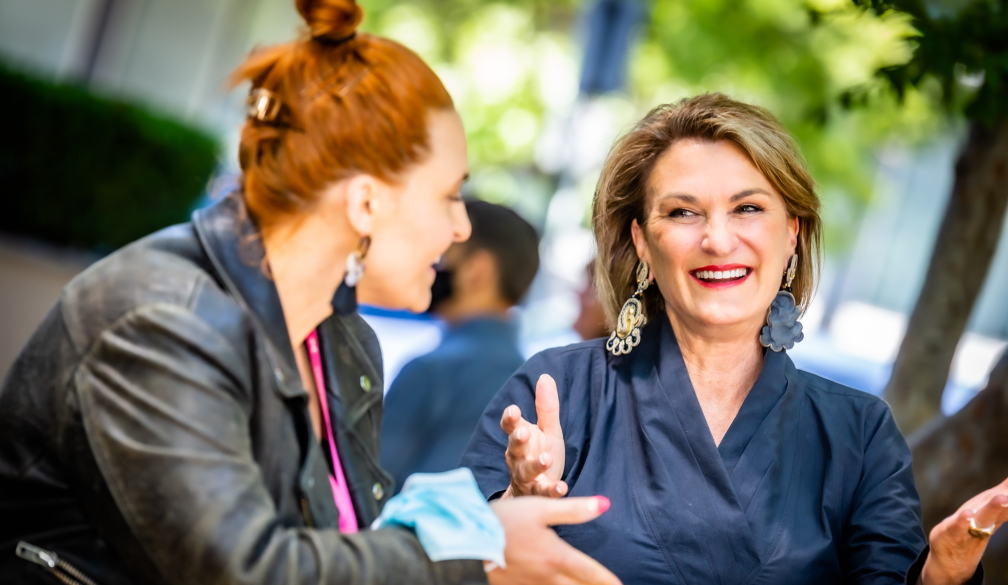How to give a good first impression when starting remotely, tips from a Body Language Expert
- Written by Body Language expert Dr. Louise Mahler

The past few years has introduced an undeniable change across all industries, with working from home now a practice implemented across the board. Due to this, the process of interviewing and also making a great first impression in the workplace has changed as many people won’t have the opportunity to do so in person. That’s why I’m here! To help you navigate through these new working conditions and make the best impression you possibly can.
A true story, I was interviewing candidates online for a position recently, and the one I chose stood out to me immediately because she was sitting up straight, looked at me directly, and smiled. Bingo - immediate fabulous first impression! We were off to a fantastic start.
Sit up straight
There are two problems with slouching. One, is that the perception of the listener is that you have no energy or enthusiasm, and secondly, is that it will actually cause you to have no energy and enthusiasm!
The problem is that a slouching body is a body that cannot breathe and will alter your ability to get air out of you when you breathe. This stops you from having enough oxygen to think clearly and will squash the vocal tract so you can’t speak clearly. Make sure your pelvis is tipped under on your seat and hold your body upright - imagine a string is pulling you from the top of your head to the ceiling.
Smile like there is no tomorrow
There are so many benefits to smiling, firstly, it will help you to be perceived in a far more positive light. Research from SmileDirectClub shows that nearly 50 per cent of Aussies find that people who smile appear warm, and 60 per cent find those who smile more welcoming. We are also inexplicably drawn to confident people, and 30 per cent of Aussies find that people who smile appear more confident.
Smiling actually has a physical impact on the function of the throat and will stop you from choking when you speak. Smile, and your voice will be produced freely and easily.
Lastly, it makes you feel good. Again, research from SmileDirectClub shows that nearly 25 per cent of Australians believe that having a nice smile will boost their confidence. So not only will you look more confident, you will actually feel more confident.
The key here is to know how to smile. There are 19 different types of smiles and the one you want is the Duchene Smile. The Duchene Smile is where the sides of the mouth go sideways and the muscles under the eyes are raised. Sometimes, this is known as smiling with your eyes. It is a critical part of the truly warm and welcoming facial expression.
Maintain eye contact
The reality of eye contact is that we all look away from the person we are speaking to when we think. In western culture, however, this trait is perceived as being untrustworthy and it stops you from being perceived as credible to the people you’re engaging with.
The good news is that we all have the ability to control our eyes and consciously maintain eye contact when we need to make an impression of credibility and trustworthiness. It just takes practice.
You may be saying to yourself “but now I’m staring. Actually it is not. A crucial trick is to remember to blink and all will seem natural and attentive. When you blink, people will no longer think you are staring and it makes it even better when you get the blink rate right. What is the blink rate? Well, research has shown that it is approximately 15 blinks a minute (one every 4 seconds). So get blinking!
Show your hands
Funnily enough, the palm of your hand is more important than you think. Showing your palms is a critical part of maintaining trust. In a video call, perhaps you could wave and show your palm on the screen, or you could count, by holding your hand up, palm front and depict numbers with your fingers. Or perhaps you could draw something in the air with your palms out to the front. Remember, you still have hands. Hidden hands can send the message that you’re trying to hide something. So, get those hands up and use them, keeping those palms for all to see.
Nod your head
Interestingly, when we become defensive, we jam our head into the back of our neck as a way of defending this very weak and vulnerable part of our body. If someone says something you don’t like, notice how you might draw your head back and lock it down. This means the head goes stiff and is a sign to the listener of a lack of flexibility, which may not be the message you want to send to your new team.
Therefore, nodding the head is a way of showing how flexible and open your thinking is. The key is the speed of the nod, and a good nod needs to be slow and smooth, not fast and jerky. Begin practising a nod with every breath. It isn’t hard once you get used to it.
Dr. Louise Mahler is a body language expert and a member of the SmileDirectClub Confidence Council.

